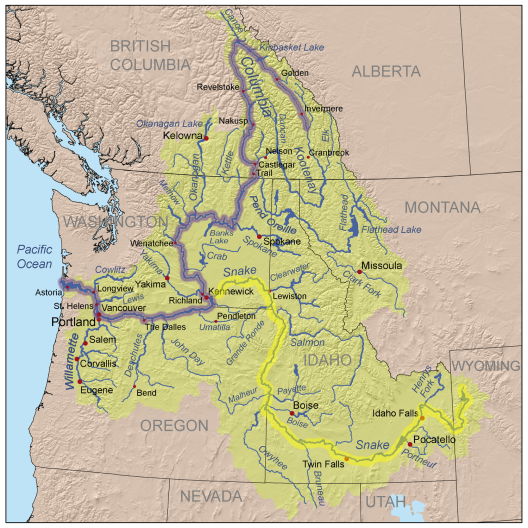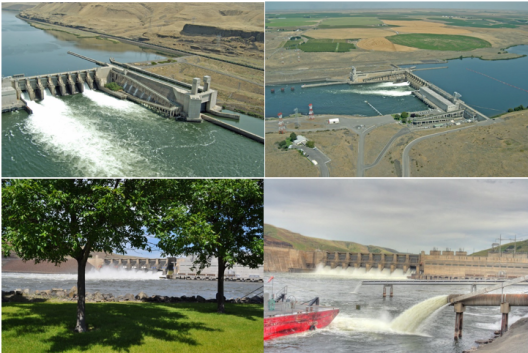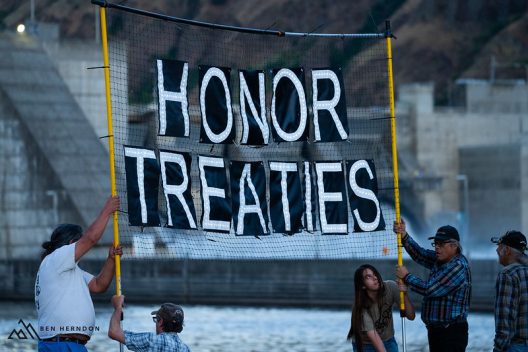Why Give A Dam About the Snake River
If you’ve ever driven through Seattle, chances are you’ve noticed signs on the lawns and in windows of homes that read “Free the Snake” or “Save Salmon, Stop the Extinction.” In recent years, these slogans have drawn attention to a key issue that threatens the survival of salmon stocks in Washington State: the lower Snake River dams (LSRDs).
The Snake River spans the borders of Washington, Oregon, Idaho, and Wyoming. It flows into the Columbia River, making the Snake the largest tributary of the Columbia. Between the 1960s and the 1970s, four dams were built along the Snake River in Washington State. These four dams—Ice Harbor, Lower Monumental, Little Goose, and Lower Granite—are managed by the Army Corps of Engineers Walla Walla District. While the dams were advertised as a source of cheap and clean electricity, community members and scientists alike insisted that these dams would negatively impact the local and regional environment and culture. Decades later, these concerns persist, and the call for removing the LSRDs grows.
“While the dams were advertised as a source of cheap and clean electricity, community members and scientists alike insisted that these dams would negatively impact the local and regional environment and culture. Decades later, these concerns persist, and the call for removing the LSRDs grows.”
Even still, there is a reluctance to remove the LSRDs due to their capacity to produce clean energy. The LSRDs produce approximately 2300 megawatts of energy for the region and 900 average megawatts of zero-carbon energy each year. As Washington State has set a net-zero emission goal by 2050, the removal of the LSRDs may make meeting these goals more challenging.


Dams: What they do and why they are there
Harnessing river flow as a means of flood control, navigation, water storage, and irrigation has a long history dating back to Mesopotamia and Egypt and has been utilized in many parts of the world. Today, there are approximately 91,754 dams across the United States that have the capacity to achieve each of these functions. However, large dam infrastructure in the United States serves another function: hydroelectricity production.
Dams produce electricity by harnessing the power of river flow as it rapidly moves downstream, typically when there is a significant drop in elevation. As the water falls it passes through and turns a turbine. The energy of the spinning turbine is passed into the generator which creates power. Through power lines, electricity is moved to power homes, businesses, etc. Since this method of producing electricity relies on the natural force of falling water, no extraction or burning of fossil fuel is required, making it a fully renewable resource. Because of this, hydroelectric dams were swiftly built along U.S. rivers throughout the 20th century.
Today, dams both large and small are slated for removal due to outdated infrastructure that does not comply with current regulations and the cost for improvements outweighs the benefits for dam operators. Many hope that the LSRDs will be next on the chopping block.

How removing dams may change the Snake River
It is hard to say exactly what will happen to the Snake River ecosystems if the LSRDs are removed. However, there are some examples of successful ecosystem recovery post-dam removal in Washington State. Perhaps the most notable example is the Elwha River, where fish populations have grown, naturally flowing sediment deposits have been restored, and native river habitats have returned. The undamming of the Elwha River is not only the largest dam removal project in the U.S. with considerable success to date, it also has the incredible potential to inform a successful recovery plan for the Snake River ecosystems.
There are three main ecological benefits of removal of the LSRDs: 1) the reintroduction of sediment deposits along the river; 2) the recovery of salmon populations in both the Snake and Columbia Rivers; and 3) the natural restoration of native riparian (riverside) plant species.
Sediment Revival:
Sediment is a crucial component of river ecosystems. Sediment deposits create habitats for a variety of river organisms, and disturbances to sediment flow can profoundly affect the rivers’ ecosystem.
Dam infrastructure interrupts the natural flow of sediment, which disturbs the natural “structure and function of downstream ecosystems.” Sediment deposits along rivers provide local fish with habitat like spawning grounds and allows for native plant life to flourish. In the case of the Snake River, dams lead to significant sandbar erosion downstream, therefore preventing the growth of riparian vegetation as a result of a lack of sediment passing through dam infrastructure. LSRDs removal may be a significant solution to improve effective sediment flow and allow for restoration of eroded sandbars. Upon removal, trapped sediment will be released and flow freely with the river, distributing itself throughout the downstream ecosystem and supporting the growth and health of riparian organisms.
Prior to the undamming of the Elwha River, sediment flow through the river and to the coast of the Olympic Peninsula was limited, causing significant erosion. After the dams were removed, sediment began to flow freely, allowing the ecosystem to naturally rectify itself and counteract erosion. As a result, salmon are now able to access habitats once lost.
Fish Stock Recovery:
As part of the Columbia River Basin, the Snake River serves as a home and spawning grounds for a variety of salmon and steelhead. There are 16 fish stocks that reside and travel through the interior of the Columbia River Basin, five of which spawn in the Snake River. Of these five stocks, three are considered threatened (Snake steelhead, Snake fall Chinook, Snake spring/summer Chinook), one is endangered (Snake sockeye), and one is already extinct (Snake coho).
The National Oceanic and Atmospheric Administration (NOAA) takes great care to monitor and mitigate salmon and steelhead population decline in the Columbia River Basin. In light of their work, NOAA has stated that the solution to preventing further population decline of Snake River fish stock is the removal of the LSRDs.
In this report, NOAA explains that dam infrastructure has two primary detrimental impacts on fish health and mortality. Fish—especially juveniles—swimming downstream through the hydropower system puts significant stress on individuals, therefore increasing mortality rates. The impacts of stress may be underestimated as the effects can be delayed, resulting in death shortly after arrival in the ocean. What’s more, hydro systems can create barriers that either fully inhibit or limit the ability of salmon and steelhead to access traditional spawning grounds, meaning that the fish may be unable to reproduce, resulting in population decline.
In order to prevent further stressors on salmon and steelhead stock survival and spawning, NOAA calls for the removal of the LSRDs. The Snake River stock will then have a chance to recover as the downstream travel time of young fish will decrease, stress exposure in hydro system passage will be reduced, and access to traditional spawning waters will be restored.
Riparian Vegetation:
Riparian plant communities are a critical part of the river ecosystem. Dams significantly impact the diversity and growth of riparian plant species due to the restriction of water and sediment flow which changes flood regimes and limits seed transport rates. As we know, free-flowing sediment plays various roles in the river ecosystem, one of which is creating riverbanks where vegetation can flourish. A reduction in sediment and water flow also leads to fewer seeds flowing downriver and fewer opportunities for plants to grow. What’s more, disrupting natural flooding patterns can impede or aid in plant production.
A 2011 study demonstrated the effects of large dams on downstream river vegetation by comparing the distribution of the sandbar willow along the banks of the Snake and Salmon Rivers. Along the Snake River, which lacks sandbars due to dam infrastructure, the sandbar willow was not nearly as abundant as along the Salmon River, an undammed river. This demonstrates how the LSRDs alter natural ecosystem processes like vegetation growth due to the restriction of sediment flow. Similarly, after the Elwha River dams were removed, riparian plant communities increased by 31% over the course of seven years.
The LSRDs and tribal rights
The consequences of the LSRDs on tribal life and sovereignty are too far-reaching to comprehensively address in this article. There are others more knowledgeable than I that have written extensively on this topic. In the following section, I have hyperlinked some articles that highlight the struggles tribes have faced and continue to face as a result of dam infrastructure along the Snake River. I strongly encourage you to explore these articles and seek other resources on this topic.
The treaty rights and livelihoods of Indigenous tribes lies at the heart of the issues surrounding the LSRDs. Adding to a long history of settler colonial land theft and resource exploitation, the LSRDs provide little benefit to the tribes that reside along the Snake River. The LSRDs contribute to the loss of salmon, steelhead, and other important fish that tribes such as Nez Perce, Yakama Nation, Confederated Tribes of Umatilla Indian Reservation, and others have relied on as a staple food source since time immemorial. The reduction in abundance and access to this food source has profound effects on tribal members. Impacts include but are not limited to the violation of treaty rights, decline in health, and reduced connection to ancestral lands, practices and spirituality.


What’s Next?
The fate of the LSRDs remains unclear as the dams are not yet slated for removal. Despite research and knowledge of the effects of the LSRDs on salmon and steelhead populations, river ecology, and tribal sovereignty there remains resistance at the state and federal level. The barrier to remove the LSRDs for Governor Inslee (D) of Washington is the fact that the dams produce renewable energy, recreational, and economic benefits. However, both Gov. Inslee and Senator Murry have been open to exploring the possibility of removing the dams if the benefits and services the dams create can be replaced by alternatives. Reports such as the LSRDs: Benefit Replacement and the Power Replacement Study have been tasked with examining replacement options.
“The fate of the LSRDs remains unclear as the dams are not yet slated for removal.”
While it is necessary to examine the alternatives to the LSRDs, many feel as though there is no time left. There is a strong push on the local level to remove the LSRDs in order to recover important fish populations and restore the river’s ecosystem. Tribes, community members, and nonprofits alike continue to push for the removal of the LSRDs. To learn more and get involved, please visit Colombia River Keeper and the Waterkeeper Alliance.
Author’s note:
I believe information should be as accessible as possible. I personally strive to cite as much open source material as possible in my work. Unfortunately, some information discussed in this article is behind paywalls. In an attempt to make the sources cited in this article accessible, a copy of the sources will be provided upon request. I encourage you to reach out.
Contact Currents’ Editor-in-chief for access to the following publications cited in this piece:
Bednarek, A. T. (2001). Undamming Rivers: A Review of the Ecological Impacts of Dam Removal. Environmental Management, 27(6), 803–814. https://doi.org/10.1007/s002670010189
Burdick, A., Olson, A., Zohrabian, A., Spencer, S., Kramer, S., & Moore, J. (2022). BPA Lower Snake River Dams Power Replacement Study. 57.
Bellmore, J. R., Pess, G. R., Duda, J. J., O’Connor, J. E., East, A. E., Foley, M. M., Wilcox, A. C., Major, J. J., Shafroth, P. B., Morley, S. A., Magirl, C. S., Anderson, C. W., Evans, J. E., Torgersen, C. E., & Craig, laura S. (2019). Conceptualizing Ecological Responses to Dam Removal: If You Remove It, What’s to Come? BioScience, 69(1), 26–39. https://doi.org/10.1093/biosci/biy152
Brown, R. L., Thomas, C. C., Cubley, E. S., Clausen, A. J., & Shafroth, P. B. (2022). Does large dam removal restore downstream riparian vegetation diversity? Testing predictions on the Elwha River, Washington, USA. Ecological Applications, 32(6). https://doi.org/10.1002/eap.2591
Rood, S. B., Goater, L. A., Gill, K. M., & Braatne, J. H. (2011). Sand and sandbar willow: A feedback loop amplifies environmental sensitivity at the riparian interface. Oecologia, 165(1), 31–40. https://doi.org/10.1007/s00442-010-1758-2